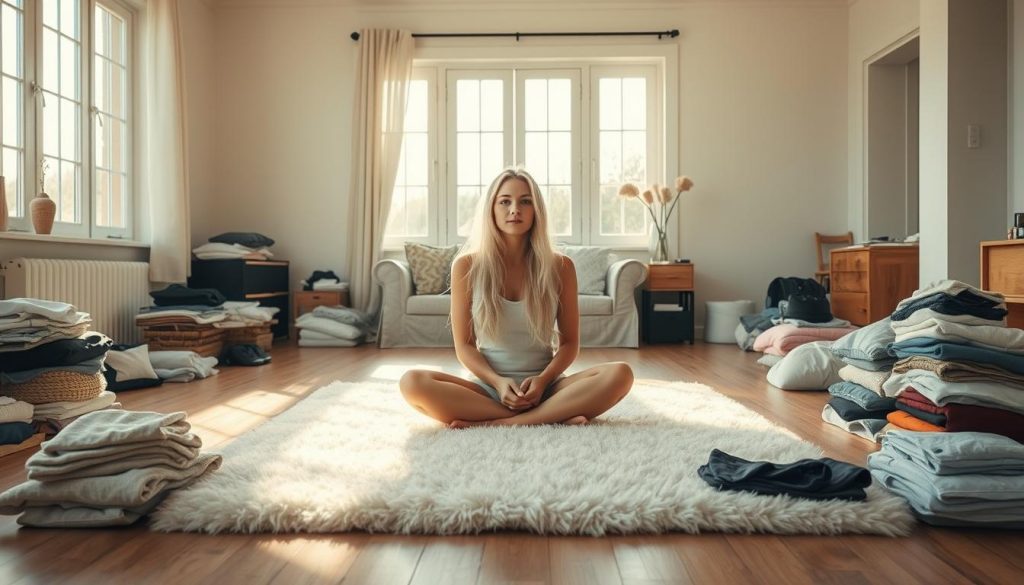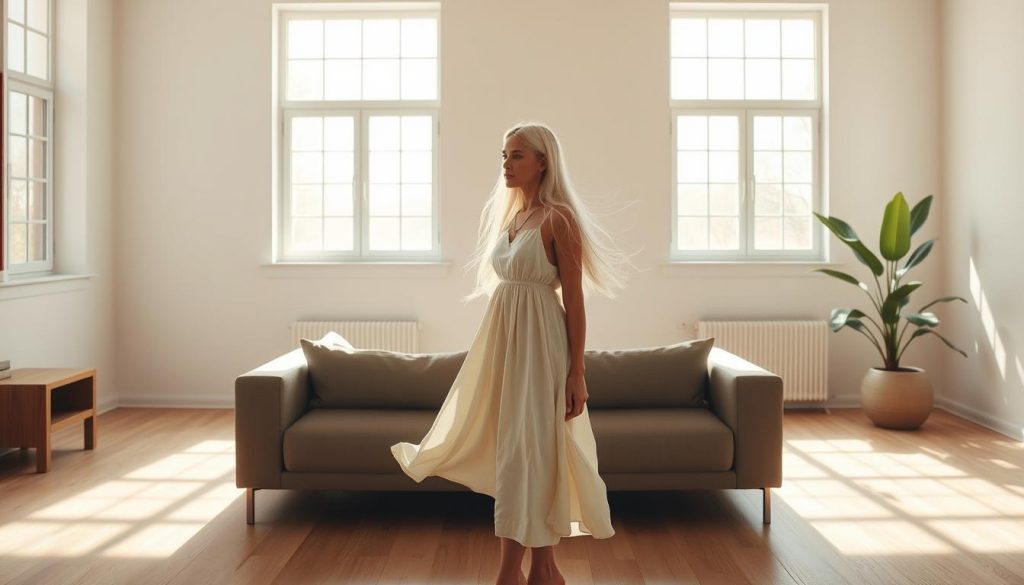11 Rules to Stop Clutter From Sneaking Back Ready to finally take back your home and your energy? What if one simple rule could keep stray things from piling up and stealing your time and calm?
I’m excited to guide you! These 11 smart rules make decluttering feel doable and even fun. You’ll learn how to spot the real problem, choose what stays, and move items along without wasting time.
This approach frees space and makes rooms feel lighter. You’ll reclaim corners of your house for the things you love, like a garage for your car or a room for a home gym. Little habits add up to big change in your life!
Think of this as a friendly playbook. One rule at a time, one action at a time, and you’ll stop fighting the same mess over and over.
Key Takeaways
- Follow 11 clear rules to prevent clutter from returning.
- Focus on a few things that matter for fast wins.
- Use simple steps: collect, choose, eliminate, organize.
- Small daily habits protect your space and calm.
- You’ll save time and make your home more functional.
Why a Clutter‑Free Home Matters Right Now
A calm room is the fast track to less stress and better focus. You feel it immediately—your shoulders drop and your breath slows when the space around you clears. Visual noise pulls attention away and makes it harder to start tasks.
Less stress, more focus: how a tidy room boosts your day
Science backs this up! Piles and visual chaos link to higher daily cortisol levels for many women and raise stress across the household. When a room is tidy, your brain has fewer distractions and you focus faster.
That focus saves time. You stop hunting for things and get back to work, family, or rest with less friction.
Those piles aren’t harmless. They cost minutes each week, strain relationships, and even raise moving or storage expenses. A lighter space makes your home look better and feel more peaceful.
- Less stress: calmer mornings and easier evenings.
- More time: fewer searches for lost items.
- Better relationships: shared spaces run smoother when everyone can see the floor.
Think of decluttering as choosing a home that supports your life, not a problem you constantly manage. Small steps add up—start today and notice the difference!
Set Your Mind First: Make Peace With Letting Things Go
Before you sort a single drawer, give your thoughts a gentle check. When your mind is calm, decisions feel easier and kinder.
Notice the mental load: cortisol and overwhelm
Stress shows up as tightness and tiredness. Piles can raise cortisol and zap your energy. That makes decision fatigue worse and the whole problem feel bigger.
Self-compassion over shame
You’re allowed to keep memories. You also deserve a home that supports your life! Name the stories that hold you back—“I might need it,” or “It belonged to them.”
“You keep the memory, not every item.”
If you feel stuck, CBT helps. It teaches tools to face guilt, grief, or anxiety tied to possessions. Talk with loved ones. Set small steps. Honor a few meaningful things and let others go.
| Mindstep | Action | Why it helps |
|---|---|---|
| Notice | Pause and name the feeling | Reduces reactive choices |
| Decide small | One shelf or one box | Builds momentum |
| Part gently | Photo, thank, donate | Protects memories, frees space |
Rule One: Clear Surfaces, Clear Mind
Choose one flat zone and vow to keep it clear; that tiny habit sparks big change! Start with a counter, entry table, or desk and treat it like sacred space in your home.
Leo Babauta suggests removing everything from floors and flat surfaces except one or two essentials. That simple move helps the whole room breathe and gives you a visible win fast!
Protect your starting zone and keep flat spaces free
- Pick one surface and make it 100% clear daily.
- Sweep everything off, put things away, and let the open look reset your mind.
- Keep a single beautiful anchor on the surface; the rest goes to its proper place.
- Clear floors and tabletops make your room feel bigger and cut piles quickly.
- Set a tiny timer and return items to their place—this takes almost no time but saves you time later.
When stuff lands, move it away immediately and guard that boundary. One clear surface leads to another. Keep going—you’ll love the ripple effect!
Rule Two: Designate a Home for Every Item
When each item has a simple home, the whole house breathes easier! A clear spot for things stops them from wandering and creating clutter.
Give every object a seat. Teach your family where keys, chargers, and remotes live. Make returning things the default habit—you’ll save time and stress.
Only keep what you actually use
If an item doesn’t earn its place, let it go or rehome it. Limited storage helps you choose what truly fits your life. That way, your space sets the rules, not your stuff.
- Give each of your items a clear place to live—calm rises when homes exist.
- Group clothes by type and season for faster mornings.
- Use simple bins and labels so resets take seconds, not hours.
- When new things enter your home, choose a place immediately—or don’t keep them.
“Little returns beat big cleanups every time!”
| Zone | Daily Items | Storage Tip |
|---|---|---|
| Entry | Keys, masks, bags | Wall hook + small bowl |
| Living room | Remotes, chargers, glasses | Tray or basket on table |
| Closet | Seasonal clothes | Group by type; rotate seasonally |
Clutter Decision Frameworks That Stick
Simple frameworks help you decide what stays and what goes—quickly and kindly. Pick a system and stick to it for one session. You’ll feel progress fast!
Four-box method: Grab four boxes and label them Keep, Donate, Sell, Throw Away. This visual setup is perfect for small spaces. Move each item once. Decide and place it in a box immediately!
KonMari by category asks you to sort by clothes, books, paper, komono (misc), then sentimental items. Start with easier categories so your confidence builds. Ask, “Does this spark joy or real utility?” If not, thank it and let it go.
“Handle each item once and make that choice fast.” — Leo Babauta
- Use a “maybe” box for the few tricky things and set a calendar reminder for six months.
- Tackle a decluttering single shelf, drawer, or corner first for a visible win.
- Track the number items you remove this week — seeing totals motivates you!
- Protect momentum: donate or sell the same day so the rid rest doesn’t creep back.
| Method | Best for | Quick tip |
|---|---|---|
| Four-box | Small rooms, fast rounds | Label clearly; move items once |
| KonMari | Category sorting (clothes, books, paper) | Start with clothes; save sentimental for last |
| Maybe box | Uncertain keepsakes | Seal, date, review in six months |
If you keep saying “someday,” choose one item to get rid of right now. That tiny action breaks the cycle and makes the next decision easier. You’ve got this!
Make Decluttering Easy: Small Wins, Timed Sessions
Start with a mini mission: one drawer or one corner for ten minutes. You’ll spend minutes and get a real win. Quick bursts beat marathon sessions every time!

Visualize the after. See clear surfaces and open space before you begin. That image guides each fast decision and keeps the process simple.
Spend minutes, not marathons
Set a 10–20 minute timer. Pick a single spot—drawer, counter, or corner—and move side to side across the room like a ski slope. This way you cover every zone without overwhelm.
Keep it light and fast
- One pass, one decision per item—no second-guessing.
- Hang or fold a few clothes; quick actions add up.
- Keep a donate bag near your work zone for easy offloads.
- If you’re tired, stop and take time to rest—come back fresh.
“Short sessions build habit; small wins create momentum!”
Rotate areas daily so the whole room improves over weeks. This is a friendly, doable way to tame clutter and teach your brain to love order. You’ve got this!
| Session | Duration | Target |
|---|---|---|
| Micro | 10 minutes | One drawer or shelf |
| Short | 15–20 minutes | Corner or hot spot |
| Stretch | 30–45 minutes | One room side-to-side |
Rules That Prevent Re‑Cluttering
A few simple habits stop backslide and keep your rooms calm. These are practical rules you can use today to protect the work you’ve done and make your house feel lighter!
One in, one out: When a new thing arrives, send one like it away. This rule keeps volume steady and teaches quick decisions.
Limit storage on purpose. Use only the space you need. If new items don’t fit, it’s time to get rid of what you don’t use.
- Book 15-minute weekly sessions on your calendar to reset before piles form.
- Keep donation bags handy so things leave fast, not someday.
- Defend clear floors and surfaces like VIP zones—no parking allowed!
- When you buy, choose the outgoing item at the same time—no exceptions.
Consistency wins. Tiny, regular moves take minutes and stop clutter from returning. Do quick room check‑ins and your home will stay ready for life!
“Little routines keep space light for good!”
Gamify and Go: Turn Letting Go Into Momentum
Want a playful way to clear your space and keep energy high? Games add speed and joy to the process. They make decisions simple and fun so you keep moving!

The Minimalism Game asks you to remove 1 thing on day 1, 2 things on day 2, and so on. Do this for 31 days and you’ll hit 465 items if you finish. Donate, recycle, or sell each item. Track the number items you remove and celebrate streaks!
The Packing Party
Box most possessions as if you’re moving. Only unbox what you truly use over several weeks. After that test, confidently get rid of the rest. Be careful with documents and seasonal clothes—set them aside first.
- Stage sturdy boxes in a corner so the plan stays visible.
- Set a daily timer; short sprints make letting go easier.
- Invite a friend to play or keep a log of wins for motivation.
- Use this way to see what serves your home and what doesn’t.
“Make it social, keep it simple, and enjoy the lightness!”
Paper, Digital, and Everyday Stuff: Tame the Constant Stream
Tame the flood of mail and files with one simple inbox and a five‑minute habit. Set a clear spot at home for paper so mail, receipts, and school notes stop scattering across surfaces.
Create one inbox and file fast
Funnel everything into one paper inbox. Open mail once and decide: trash, file, or action. This keeps piles small and decision fatigue low.
Reduce digital noise
Unsubscribe from lists you no longer read. Sort files into simple folders and delete what you longer need. Treat e‑books and PDFs like books—only keep what you’ll use.
- Daily five‑minute pass: toss junk, file essentials, note one action.
- Clear desktop weekly: downloads and desktop reset save you time.
- Scan and recycle: digitize what matters, recycle the rest.
- Keep everyday items where you use them: fewer steps, smoother room flow.
| Target | Quick process | Why it helps |
|---|---|---|
| Mail & receipts | Inbox → trash/file/action | Stops paper piles |
| Digital files | Unsubscribe → folders → delete | Saves search time |
| Books & PDFs | Keep only what you use | Lighter storage, calmer home |
| Everyday items | Store where used | Reduces friction and saves time |
Finish each reset with a two‑minute review. Tomorrow’s you will thank you for the calm walk into your home!
People, Places, and Habits: Make It Work for Your Whole Home
Get everyone on the same team so your home keeps working for you! Teach simple routines and model them. When people see you return items and praise quick resets, they follow fast.
Set shared rules for places and small chores. Agree on clear counters each night and laundry put away by bedtime. A short weekly reset for common areas keeps the house calm and saves time.
Teach loved ones where things belong
Show kids and partners the place for keys, backpacks, and chargers. Make it a team sport—point it out, practice it, and celebrate wins! Small praise creates steady habits.
Watch impulse buys with a 30‑day list
When you want a nonessential item, write it on a 30‑day list. Most impulses fade. After 30 days, decide to keep it or get rid. This simple pause stops piles before they start.
When possessions point to something deeper
Sometimes excess items reflect stress, ADHD, or grief. If your pattern feels bigger, a short course in CBT or talking with a therapist can help. CBT gives concrete steps to change thoughts and behavior with care.
- Make it a team sport—show people where things live and praise quick resets.
- Keep a small outbox by the door so possessions leave the home quickly.
- Build tiny rhythms: five‑minute sweeps after dinner, two‑minute returns before bed.
- Name the why with loved ones: more ease, more time together, less friction.
| Action | Who | Why it helps |
|---|---|---|
| Nightly clear counters | Everyone | Keeps common areas ready and reduces morning stress |
| 30‑day wants list | Individual | Limits impulse buys and protects space |
| Weekly shared reset | Household | Creates steady upkeep and shared pride |
| CBT or support | Person seeking help | Addresses deeper causes and builds coping skills |
Your whole home works when people, places, and habits point the same way. Make decluttering a shared routine and enjoy more calm, more time, and a simpler way of living!
Conclusion
This is where routine meets reward: protect your progress with easy steps! Keep a clear surface and a simple home for each item. Small choices add up and change your life.
Use the tools you learned: the 30‑day list, the maybe box, and the four‑box course to speed decisions. Tiny daily resets beat big cleanups every time.
When emotions make getting rid hard, be kind and take time. If a few stubborn things linger, park them and decide on your scheduled date.
You’ve decluttered—now lock it in. One in, one out, right‑sized storage, and a steady process keep your home light and joyful. Let’s make decluttering a life‑long way forward!
Elevate your spiritual journey with Conscious Items’ genuine gemstones, trusted by thousands and backed by a 30-day money-back guarantee. Don’t let these powerful crystals pass you by—stocks are limited, and the perfect one for you is waiting! Visit Conscious Items now to find your crystal match before it’s too late.
If you liked reading this article you will love this article Minimalism Checklist: The ONLY Checklist you need
Morganite Crystal Healing Properties
Habits of Healthy Relationships: 10 Keys to Lasting Love: The Ultimate Love Stone for Heart Healing



